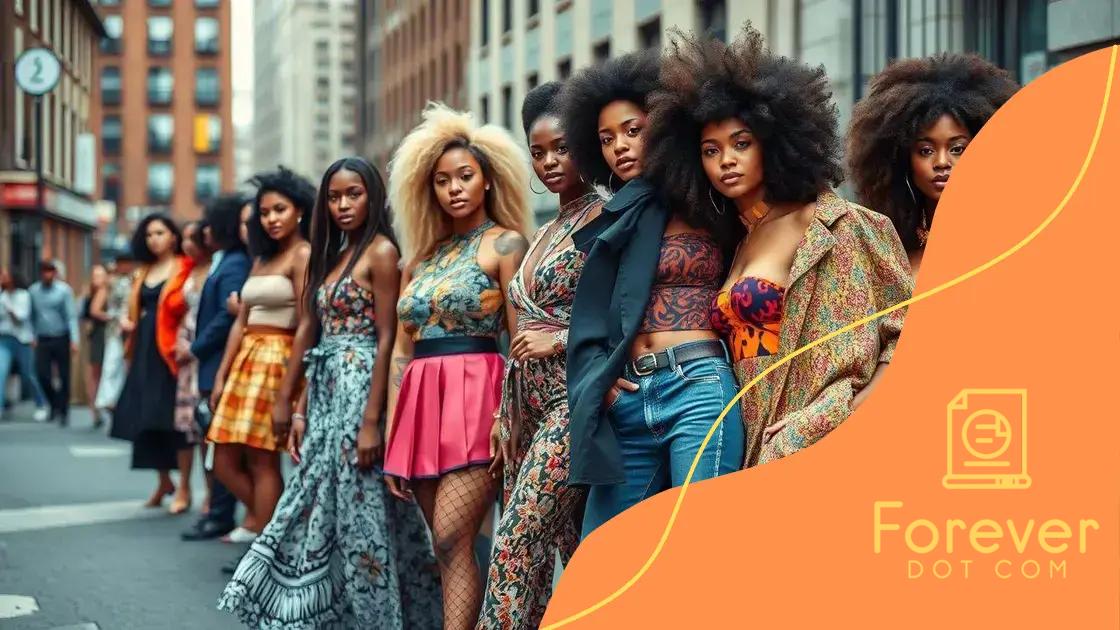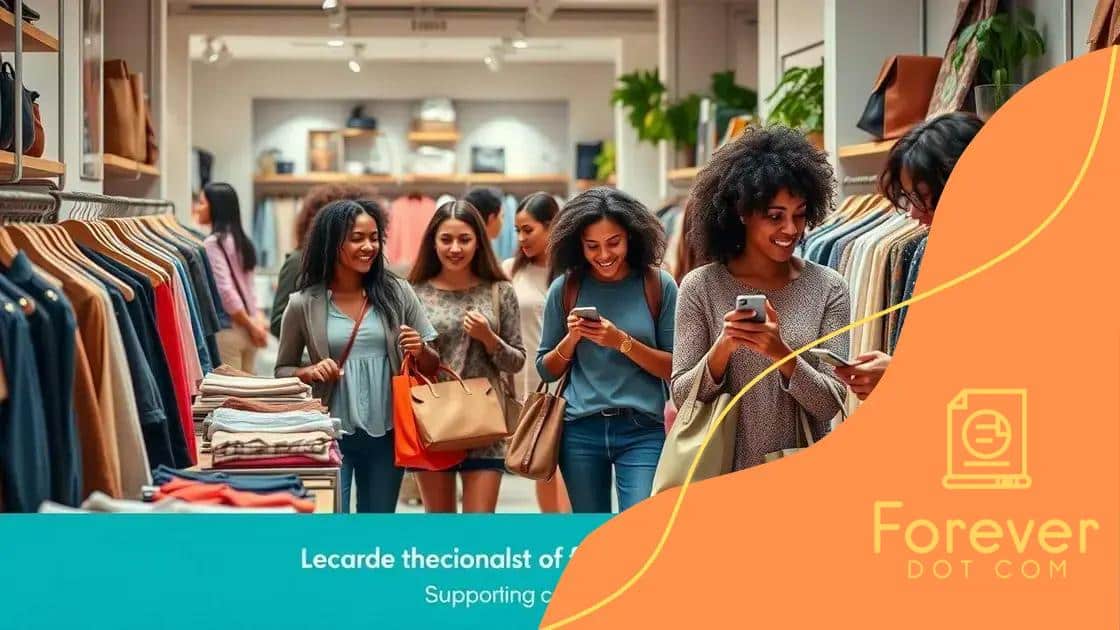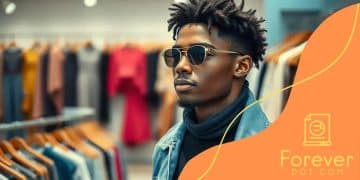How fashion brands are embracing inclusivity

Fashion brands are embracing inclusivity by expanding size ranges, utilizing diverse models, and implementing technology, which enhances consumer connection and loyalty while reflecting a more diverse marketplace.
How fashion brands are embracing inclusivity has become a vital topic in today’s industry. As consumers demand more representation, brands are responding in new and exciting ways. Ever thought about how this affects your shopping choices?
The importance of inclusivity in fashion
Understanding the importance of inclusivity in fashion is crucial in today’s market. As consumers grow more diverse, their expectations for representation in fashion also evolve. Brands must recognize that inclusivity isn’t just a trend; it’s a necessity that can define their success.
Why Inclusivity Matters
Inclusivity in fashion means creating styles that cater to all body types, skin tones, and personal styles. When brands embrace inclusivity, they not only reach a wider audience but also foster a sense of belonging.
Key Benefits of Inclusivity
- Enhances customer loyalty by making everyone feel valued.
- Boosts sales as diverse offerings appeal to broader demographics.
- Encourages positive brand perception among consumers.
- Drives innovation by challenging traditional fashion norms.
Moreover, the shift toward inclusivity reflects broader social change. Consumers today are more informed and demand that brands represent them authentically. This change is not just about size; it includes race, gender, and personal identity.
Moreover, leading brands show that aligning with inclusivity can be a catalyst for creative expression. By bringing various voices into the design process, fashion can reflect the richness of individual experiences. This results in unique pieces that resonate with consumers from all backgrounds.
In addition, the challenges faced by brands in embracing inclusivity should not be overlooked. It requires a profound commitment to change, often from the ground up. This involves addressing supply chain issues, ensuring diverse marketing campaigns, and fostering an inclusive company culture.
As brands continue to navigate these changes, it becomes evident that inclusivity is more than just adding a few sizes to a collection. It’s about creating a space where everyone is represented and feels welcome.
Examples of brands leading the change
Many brands are at the forefront of promoting inclusivity in fashion. They demonstrate how investing in diversity can lead to innovative styles and a loyal customer base. Their commitment to change inspires others in the industry.
Notable Brands Leading the Change
Several fashion labels are working to redefine standards, creating products that cater to various sizes, shapes, and cultures. These brands show how powerful inclusivity can be.
- Savage X Fenty: This lingerie line by Rihanna features models of all sizes and promotes body positivity.
- Aerie: This brand has gained popularity for its ‘Aerie Real’ campaign, which showcases unretouched photos of models.
- Universal Standard: Focused on size inclusivity, this brand offers apparel from size 00 to 40, aiming to serve every body.
- ASOS: Known for its wide range of sizes and styles, ASOS frequently collaborates with diverse influencers to represent various communities.
These brands illustrate that inclusivity can appeal to a wider audience while creating a positive social impact. When brands prioritize representation, they connect more deeply with their customers.
Moreover, the shift towards inclusivity is also evident in marketing strategies. Brands are moving away from traditional beauty standards. Instead, they collaborate with models representing various backgrounds, ages, and body types. This approach not only appeals to the current consumer base but also paves the way for future generations to feel represented.
The growing demand for inclusivity leads brands to change how they design, market, and sell their products. As consumers increasingly seek authenticity, brands that embrace inclusivity are more likely to thrive. They are shaping how fashion looks and who it represents in today’s world.
The impact of inclusivity on consumer behavior

The impact of inclusivity on consumer behavior is profound and far-reaching. As brands embrace diverse representations, they are shaping how customers perceive and interact with fashion. When consumers see themselves reflected in advertisements and products, they feel a stronger connection to the brand.
Understanding Consumer Preferences
Inclusive marketing can significantly influence purchasing decisions. Customers today prioritize shopping from brands that reflect their values. They want to support businesses that celebrate diversity.
- Increased Loyalty: Consumers are more loyal to brands that support inclusivity.
- Higher Engagement: Brands that showcase diversity see improved engagement with their audience.
- Positive Word-of-Mouth: Customers are likely to recommend brands that make them feel seen and valued.
- Broader Appeal: Inclusive brands attract a wider range of shoppers.
Moreover, as industries evolve, so do the expectations of consumers. They actively seek out brands that demonstrate a commitment to social responsibility. When a brand’s mission aligns with a customer’s values, it creates a powerful bond.
For example, studies show that shoppers are increasingly willing to pay more for products from companies that prioritize diversity. They seek brands that offer not just products, but also a sense of community and acceptance. This emphasizes how inclusivity can boost a brand’s reputation and sales.
On the other hand, brands that overlook inclusivity risk alienating potential customers. They may face backlash or even boycotts. Therefore, understanding the impact of inclusivity on consumer behavior is essential for brands aiming to thrive in today’s competitive market.
Challenges fashion brands face
Despite the progress in inclusivity, fashion brands face various challenges when trying to implement change. Addressing these issues is crucial for creating a truly inclusive environment.
Barriers to Inclusivity
Many brands struggle with the initial transition towards inclusivity. One major barrier is changing long-established company cultures. This change requires commitment from leadership to prioritize diverse representation in hiring, marketing, and product development.
- Supply Chain Issues: Sourcing materials and producing a wider range of sizes can complicate logistics.
- Market Misunderstandings: Brands sometimes misjudge the actual needs and preferences of diverse customers.
- Cost Concerns: Producing inclusive collections can require more investment, which some brands are hesitant to make.
- Limited Awareness: Some brands do not fully understand the importance of inclusivity and how it can affect their bottom line.
Moreover, there is a persistent stigma surrounding body diversity. Many brands fear that offering a broader range will dilute their brand identity. This concern often leads them to stick with traditional models of beauty, which can alienate potential customers.
To overcome these challenges, brands need to foster an understanding of their customer base. Engaging in conversations with diverse groups can help identify specific needs and promote a sense of community. Feedback from customers can guide brands in creating effective marketing and product strategies.
Additionally, education on topics of inclusivity is vital. Training staff to understand the significance of diversity can help transform company culture. This change can inspire meaningful connections with customers and enhance overall customer experience.
Future trends in inclusive fashion
The future trends in inclusive fashion are shaping a new landscape in the industry. As awareness of diversity and representation grows, brands are adapting to meet the expectations of their consumers.
Emerging Trends
One key trend is the increasing use of technology to enhance inclusivity. Brands are now using advanced data analytics to understand customer preferences better. This data helps in designing products that cater to a wider range of body types and styles.
- Virtual Fitting Rooms: Customers can try on clothes virtually, which makes shopping easier and more accessible.
- Size Customization: More brands are offering customizable sizes, allowing shoppers to input their measurements for a tailored fit.
- Sustainable Practices: As consumers become more environmentally conscious, brands will increasingly focus on sustainable and ethical production methods.
- Diverse Representation: Expect to see more diverse models and campaigns that reflect the broad spectrum of consumers.
Another trend is the collaboration between brands and inclusive fashion influencers. These influencers can highlight the needs and desires of various communities, urging brands to expand their offerings.
Additionally, there is a growing demand for gender-neutral fashion. Consumers are pushing for styles that do not conform to traditional gender norms. This opens doors for brands to create collections that appeal to all genders, promoting fluidity in clothing choices.
As we look ahead, it’s clear that the future of fashion will be inclusive, diverse, and forward-thinking. Brands that adapt to these trends will likely thrive while building loyal customer bases. By prioritizing inclusivity, they will transform not just their offerings but the entire fashion industry.
FAQ – Frequently Asked Questions about Inclusivity in Fashion
Why is inclusivity important in the fashion industry?
Inclusivity is important because it ensures representation for all individuals, helping consumers feel valued and understood.
How can brands embrace inclusivity effectively?
Brands can embrace inclusivity by offering diverse sizes, collaborating with various models, and promoting authentic representation in their marketing.
What are some common challenges brands face when promoting inclusivity?
Common challenges include changing company culture, supply chain issues, and the fear of alienating traditional customer bases.
What future trends should we expect in inclusive fashion?
Future trends include the rise of gender-neutral clothing, customized sizing options, and increased use of technology to enhance the shopping experience.






